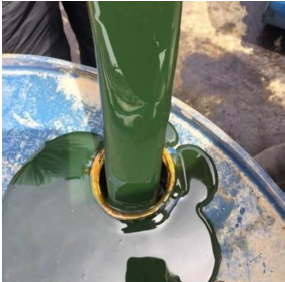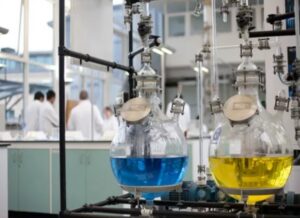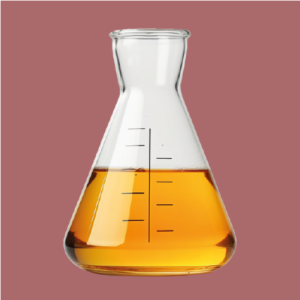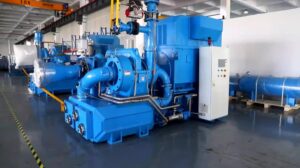How Bitumen is Produced: Extraction and Refining Processes
Bitumen is one of the products of petroleum used to make roads and is even used in roofing. It was obtained from crude oil and underwent a series of complicated extractions and refining techniques before the resulting usable product would be supplied. It would therefore be important to know how bitumen is processed so as to evaluate its quality and possible uses and their environmental impact.
What is Bitumen?
Bitumen is known as asphalt in the United States; it is formed through the distillation of crude oil and exhibits both waterproofing and adhesive characteristics. When bitumen is formed through distillation, it rejects the lighter crude oil components, like gasoline and diesel, and tends to leave behind the “heavier” bitumen, which can be refined a few times before its grade improves. There also occurs natural bitumen: Layers of a natural bitumen are deposited at the bottom of ancient lakes, where prehistoric organisms have long since rotted and subjected to heat and pressure.
Bitumen is a viscous, nonvolatile liquid or solid. Bitumen is a complex colloid system, and its chemical properties depend on the properties of crude oil from which it is produced. Pure bitumen is a colloid dispersion of microscopic asphalt particles (dispersion phase). Chemical composition of bitumen is a mixture of different hydrocarbons with molecules of oxygen, sulfur, and nitrogen. Hydrocarbons present in the bitumen are mainly condensed naphthene and aromatic rings with the small number of side paraffin chains. Mass fraction of hydrocarbons is 75-85%, hydrogen 9-10%, oxygen 2-8%, sulphur 5-7%, and nitrogen 0.1-0.5%. Bitumen is partly or fully soluble in a number of organic solvents. Dissolved fractions of bitumen insolvent are termed maltenes or petrolenes, and undissolved fractions are termed asphaltenes. Maltenes are a mixture of resins and oil, and they are a dispersing agent. Generally speaking, the physical properties of bitumen are sensitive to the dispersion degree of asphaltenes in maltenes.
Understanding BITUMEN
Is bitumen crude oil? Bitumen is in general intended for industrial application. Asphalt was first used as such for its natural adhesive and waterproofing properties but also as a medicine. It was applied to bind building materials together, apart from outlining the bottoms of ships. The material was traded between ancient civilizations. The walls of ancient Babylon contained bitumen, as Herodotus, a Greek historian of the fifth century BC claimed.
Asphalt is a byproduct of complex hydrocarbons, including the elements calcium, iron, sulfur, and oxygen. Quality of the material as well as its ease of manufacture depends on the source and type of crude oil from which it is derived. The material is used most often in road paving. Most roads in the United States are made of either bitumen or of a combination of bitumen and aggregates, such as concrete. Engineers can reuse the material elsewhere in other road construction. It is also applicable for using it since it is impermeable in the production of roofing material.
Asphalt may deform permanently when subjected to heavy loads. This will depend on the asphalt mixture composition, the ambient temperature, and on stress that puts on material. Asphalt oxidizes which can leave the asphalt brittle and crack.
Types of Bitumen
Paving Grade Bitumen
- Commonly used in road construction. Examples include VG-10, VG-20, VG-30, and VG-40, where VG indicates Viscosity Grade.
Cutback Bitumen
- Bitumen mixed with solvents to reduce viscosity for easier application. Types include Rapid-Curing (RC), Medium-Curing (MC), and Slow-Curing (SC).
Emulsion Bitumen
- A mix of bitumen, water, and emulsifying agent, used for cold applications. Available as cationic (positive) or anionic (negative) emulsions.
Oxidized Bitumen (Blown Bitumen)
- Produced by blowing air through hot bitumen. Grades include 85/25, 90/40, and 115/15, based on penetration and softening point.
Polymer Modified Bitumen (PMB)
- Enhanced with polymers to improve elasticity, strength, and resistance to deformation.
Bitumen Penetration Grade
- Classified by penetration values like 30/40, 40/50, and 60/70, commonly used in moderate climates.
Hard Grade Bitumen
- Stiffer grades used in industrial applications or for heavily loaded pavements.
Natural Bitumen
- Found naturally as Gilsonite or in deposits, used for paints, coatings, and adhesives.
Each type of bitumen serves specific applications based on performance requirements like temperature resistance, traffic load, and environmental conditions.
USES OF Bitumen

It is a mixture of dense, sticky, viscous organic liquids, mainly consisting of polycyclic aromatic hydrocarbons. Asphalt occurs naturally or is obtained as a by-product by the distillation of crude oil.Naturally occurring or crude bitumen is a sticky, tar-like form of petroleum that is so thick and heavy that it must be heated or diluted before it will flow. At room temperature, it is much like cold molasses. Refined Asphalt is the residual (bottom) fraction obtained by fractional distillation of crude oil. It is the heaviest fraction and the one with the highest boiling point, boiling at 525 °C (977 °F).
In British usage, Asphalt refers to a compound of mineral aggregate and bitumen-or tarmac in street language. Tar refers to the black viscous material resulting from the destructive distillation of coal and is thus chemically different from bitumen. In U.S. usage, Bitumen is known as ‘Asphalt’ or ‘Asphalt cement’ in engineering parlance. In Australian English, Bitumen sometimes refers to road surfaces in general. The word refers to the huge Canadian deposits of extremely heavy crude oil in Canadian English, while the term asphalt is used for the oil refinery product that is used to pave roads and manufacture roof shingles. Diluted Bitumen (diluted with Naphtha so that it would flow in pipelines) is known as dilbit in the Canadian Petroleum industry, and the bitumen upgraded to synthetic crude oil is known as syncrude and its blend with bitumen as a syn bit
Most bitumens contain sulfur and several heavy metals such as Nickel, Vanadium, Lead, Chromium, Mercury and also Arsenic, Selenium, and other Toxic Elements. Bitumen can provide good preservation of plants and animal fossils.
Bitumen is mainly used for paving roads. Its other uses are Waterproofing Products, including the use of Asphalt in the production of roofing felt and for sealing flat roofs. Natural crude bitumen is the main feed stock for this new developing production of oil from tar sands which have been developed in Alberta, Canada. The entire majority of the world’s Natural Asphalt is located in Canada, at about 140,000 square kilometers, bigger in area than England, thus rendering it to have the second-highest proven oil reserves worldwide. The Athabasca oil sands are the largest known deposit of bitumen in Canada, and they are the only bitumen deposit currently accessible by surface mining; however, technological advancements over recent years have made deeper deposits producible via in-situ methods. In the light of the increases in oil prices since 2003, upgrading bitumen to synthetic crude oil has become highly profitable. Crude Bitumen production in Alberta by 2006 averaged around 1.1 million barrels (170,000 m3) per day and is forecast to rise as high as 4.4 million barrels (700,000 m3) per day by 2020. In total, recoverable volumes of the crude Asphalt in the province amount to approximately 310 billion barrels (50×109 m3); at a consumption rate of 4.4 million barrels per day, this volume would last about 200 years.
In the past, Asphalt was used in Waterproofing Boats, even as a coating for buildings with some additives. Herodotus, a Greek historian said that hot Asphalt was used as a mortar in the walls of Babylon. It is possible too that the city of Carthage would easily burn because of the extensive use of Asphalt in the construction. The vessels for heating asphalt or bituminous preparations are generally covered under special conditions in the public liability policies and are similar to what is applied for blow torch, welder, and flame-cutting equipment.
Asphalt was also used in the early years of photographic technology. Most famously, bitumen is used for making French scientist Joseph Nicéphore Niépce in the very first picture ever taken. The Asphalt used in his experiments was smeared on pewter plates and exposed to light, thus making a black and white image. Thin layers of Asphalt are sometimes utilised by computer enthusiasts to muffle a computer case or noisy parts of the computer, like the hard drive. Layers of asphalt are baked onto the outer walls of high-end dishwashers for sound insulation.
Bitumen Extraction: The First Step
The process of extracting bitumen can vary depending on the source. There are two primary methods used for bitumen extraction:
- Mining
- In-situ extraction
1. Mining Method
Most of the bitumen extraction methods involve oil sands or tar sands mined from shallow deposits. It involves the following procedure:
Surface Mining: The oil sands are extracted from the ground by using large trucks and shovels. From there, it goes to processing facilities where the bitumen is separated from the sand, water, and clay.
Bitumen Separation: The oil sand is mixed with hot water at the facility to form a slurry. The slurry is transferred to separation vessels in which bitumen floats up and is skimmed off and the sand along with other impurities settles down.
Dilution: The extracted asphalt is then mixed with lighter hydrocarbons, called diluents, that lower the viscosity of it for its transportation through pipelines.
2. In-Situ Extraction Method
In-situ extraction is used with deeper deposits that can not be accessed by surface mining. Such methods include:
Steam-Assisted Gravity Drainage (SAGD): There are two horizontal holes drilled to the bitumen reservoir. The former injects steam through it, increasing the temperature of the bitumen to reduce its viscosity. At this point, the fluidized bitumen flows into the lower opening hole and pumped to the surface.
Cyclic Steam Stimulation (CSS): CSS is a process that injects steam into the bitumen reservoir, allows it to soak for some period of time, then produces the softened bitumen to the surface. This cycle is repeated multiple times.
Refining Processes of Bitumen
The bitumen extracted will undergo several bitumen refinery processes to enhance its quality and grade suitability in specific applications. Bitumen refining procedures involve several stages where the impurities present in the product are removed and the property of the product altered to give the desired bitumen.
1. Distillation
In the primary treatment process, distillation is the refining of bitumen. The feedstock for bitumen carries crude oil with it and is brought through a furnace before getting sent off into the distillation column. It is a two-phase process.
Atmospheric Distillation: The heated feedstock bitumen is distilled at atmospheric pressure. At this condition, the mixture separates into lighter and heavier fractions. The top fractions will have lighter fractions such as diesel and gasoline; conversely, the bottom will be the heavier residue that remains, that is, the bitumen.
Vacuum Distillation: Under vacuum pressure, the heavier residue is separated to yield heavy gas oils, lubricating oil, and vacuum residue, which are further processed to yield bitumen.
2. Deasphalting
The process of deasphalting is carried out to remove the asphaltenes, which represent some heavy and complex molecules, in the vacuum residue. With such properties, it is possible for this removal to improve the quality of the final bitumen product. Thus, using solvents like propane or butane allows the precipitation of the asphaltenes, leaving behind the deasphalted oil and the bitumen. This is a very key aspect of producing high-quality bitumen, as it will be available for use in various applications.
3. Air Blowing (Oxidation)
Air blowing involves blowing air into heated bitumen, thereby altering its properties. The oxidation process used here is accompanied by an enhancement of viscosity, hardness, and resistance to temperature change; mostly used in the manufacture of roofing grade bitumen or industrially.
Straight Run Bitumen: In the production of bitumen, this type of bitumen is made with no other form of modification but a straight run from the vacuum residue.
Blown Bitumen: Being higher in softening point and more elastic, this one is produced through the air blowing process. This is why it best performs as roofing material.
Key Quality Control Processes in Bitumen Production
Quality control measures during the refining bitumen processing for this to ensure bitumen meets the industry standard include:
- Viscosity Testing: Viscosity is a critical property determining how bitumen will behave at different temperatures. Quality control involves the testing of bitumen’s viscosity to try as much as possible to ensure it meets specifications for application.
- Penetration Test: This measures how hard or soft the bitumen is. It is done by measuring the distance a standard needle penetrates when the material is under certain conditions.
- Softening point test: done to determine the temperature at which the bitumen attains a certain degree of softness. This will be important in analyzing its performance across various climatic conditions.
Environmental Considerations in Bitumen Production
Extraction and processing of bitumen poses several environmental challenges. Significant emissions of greenhouse gases, substantial amounts of water usage, and minimal disturbance to the land are all the greatest concerns that the industry faces. Some of the considerations for the environment include the following:
- Water Management: Extraction of bitumen, mainly from oil sands, requires a huge amount of water. Recycling and treating water used in the process helps minimize these impacts.
Another major source of emission is through the process of extraction and refining, where carbon dioxide and other greenhouse gases are emitted. Cleaner technologies and carbon capture methods are in progress for reducing the emissions. - Land Reclamation: Following the mining, the land is returned to its original form or serviced with other uses in a way to minimize the impact on the surrounding ecosystem.
Applications of Refined Bitumen
Refined bitumen has numerous applications, thanks to its durability, waterproofing properties, and ability to withstand extreme temperatures. The most common uses include:
- Road Construction: Bitumen is widely used as a binder in asphalt, providing flexibility and strength to road surfaces.
- Roofing: Its waterproofing properties make bitumen an excellent material for roofing membranes and shingles.
- Waterproofing: Bitumen is used to coat underground pipelines, foundations, and other structures to prevent water ingress.
Future Trends in Bitumen Production
The bitumen industry is continuously evolving, with advancements in extraction and refining technologies. Some of the future trends include:
- Bio-bitumen: Researchers are exploring bio-based alternatives to reduce the carbon footprint of bitumen production.
- Recycling: The use of recycled bitumen from old road pavements is gaining popularity, contributing to sustainable construction practices.
- Nanotechnology: Incorporating nanomaterials into bitumen can enhance its properties, such as durability and resistance to temperature variations.
Final Thoughts
Rumanza Bitumen production process involves several steps, such as extraction from oil sands or crude oil followed by the refining of bitumen to produce the quality and properties desired. Knowledge of the production process of bitumen will benefit understanding various aspects in its applications, environmental considerations, and future directions. Due to continuous growth in demand for bitumen, the industry is embracing the use of sustainable methods that can help reduce its impact on the environment as well as guarantee good quality bitumen for different applications.
FAQs
Bitumen comes from crude oil and is obtained through the refining process. It is the heaviest fraction left after lighter fuels like gasoline and diesel are separated through fractional and vacuum distillation. Naturally, bitumen can also be found in oil sands and pitch lakes, such as those in Canada and Trinidad.
The asphalt refinery process involves fractional and vacuum distillation to separate bitumen from crude oil. It may undergo air blowing to improve viscosity before being stored in heated tanks for transportation and use in construction and industrial applications.
In the Bible, bitumen is referred to as “pitch” and was used as a waterproofing material, such as in Noah’s Ark and the Tower of Babel.
The three types are:
Paving Grade Bitumen
Oxidized Bitumen
Cutback Bitumen
Bitumen is typically transported in specialized heated tanker trucks or railway tank cars equipped with heating coils. These vehicles keep bitumen hot and viscous during transport to prevent solidification. For longer distances, pipelines are used, where bitumen is heated and pumped through insulated pipes. This method ensures efficient and continuous transportation of this viscous substance.
Another name for bitumen is “asphalt binder” or simply “asphalt” in the U.S.
Polymer-modified bitumen (PMB) and synthetic waterproofing membranes are often considered better than regular bitumen due to their enhanced durability, flexibility, and resistance to extreme temperatures.
Bitumen can last 10 to 20 years, depending on its application, quality, and exposure to environmental factors.

What is Rubber Process Oil? | Guide to Applications, Benefits, and Selection
What is Rubber Process Oil? | Guide to Applications, Benefits, and Selection Discover More In the sophisticated ecosystem of rubber manufacturing, raw polymers are the canvas, but rubber process oil is the essential medium that brings the masterpiece to life. It is the critical component that transforms rigid, unworkable raw materials into the versatile, durable, and high-performance rubber products that define modern industry and daily convenience. For specialists dedicated to chemical innovation and precision, such as the team at Rumanza Lubricants, the science

Which UAE Lubricants manufacturers is Best for High-Mileage Engines?
Which UAE Lubricants manufacturers is Best for High-Mileage Engines? Discover More The sprawling deserts and bustling metropolises of the United Arab Emirates present a uniquely demanding environment for vehicles, pushing engine lubrication technology to its absolute limits. From the scorching summer heat that can cause conventional oils to thin out and lose protective properties, to the endless stop-start traffic of cities like Dubai and Abu Dhabi that promotes sludge and acidic buildup, our cars endure a severe service regimen unlike

What Vehicles Use Kerasene? A Comprehensive Guide
What Vehicles Use Kerasene? A Comprehensive Guide to Fueling Beyond Gasoline Discover More When we think of vehicle fuel, gasoline and diesel immediately come to mind. They are the lifeblood of our daily commutes, the power behind the trucks that deliver our goods, and the standard by which we measure automotive progress. But venture beyond the everyday, into the realms of high-altitude aviation, rugged agricultural machinery, and groundbreaking space exploration, and you’ll discover a different, equally vital fuel that operates

How To Chose Antioxidant Additives in UAE | Industrial Grade Chemicals?
How To Chose Antioxidant Additives in UAE | Industrial Grade Chemicals? Discover More In the heart of a rapidly industrializing region, the United Arab Emirates stands as a beacon of manufacturing, logistics, and heavy industry. From the sprawling automotive workshops of Dubai to the massive petrochemical complexes in Ruwais, the performance and longevity of machinery are paramount. At the core of this operational excellence lies a critical, yet often overlooked, component: industrial lubricants and fluids. These lifeblood substances are constantly

Viscosity Index Improvers UAE – Improve Lubricant Performance
Viscosity Index Improvers UAE – Improve Lubricant Performance Discover More In the heart of the United Arab Emirates, where ambition is matched only by the scale of its infrastructure, the machinery that builds and powers the nation faces a relentless adversary: the climate. The combination of extreme heat, temperature volatility, abrasive dust, and intense UV radiation creates a perfect storm of conditions that relentlessly attack the lifeblood of all mechanical systems—the lubricant. For maintenance managers, plant operators, and fleet owners,

Compressor Oils UAE | Lubricants for Air Compressors
Compressor Oils UAE | Lubricants for Air Compressors Discover More In the relentless engine of the UAE’s economy, where ambition is matched only by the scale of its construction and industry, air compressors are the indispensable workhorses. They are the silent force driving the pneumatic tools that build our skylines, the automated machinery in our factories, the climate control systems in our buildings, and even the processes in oil and gas refineries. Yet, within these critical machines, a component often

How to Chose Best Diesel Engine Oil in UAE for Your Vehicle | Get Quote
Guide to Choosing the Best Diesel Engine Oil in UAE For Your Vehicle Discover More In the United Arab Emirates, the relationship between a driver and their vehicle is forged in fire. The unrelenting sun, the searing asphalt, and the ever-present fine sand create an operating environment that is among the most punishing on Earth. For the diesel engines that power the UAE’s growth—from the rugged Land Cruisers conquering dunes to the Ford F-150s on city streets and the fleets

What Are the Latest Trends in Sustainable Industrial Oils for UAE Manufacturers?
What Are the Latest Trends in Sustainable Industrial Oils for UAE Manufacturers? Discover More Industrial oils form the lifeline of heavy industries, enabling machines, turbines, compressors, and production lines to function seamlessly. They reduce friction, cool equipment, prevent wear, and ensure uninterrupted operations. In a fast-developing economy like the UAE—where energy, petrochemicals, construction, and manufacturing drive growth—industrial oils are indispensable. But today, the conversation around industrial oils is no longer limited to performance. Global concerns about climate change, carbon emissions,

UAE Brake Fluid – DOT 4 vs. DOT 5.1 Which One Should Use
UAE Brake Fluid – DOT 4 vs. DOT 5.1 Which One Should Use Discover More Brake fluid is one of the most critical yet often overlooked components in a vehicle’s braking system. It plays a pivotal role in ensuring that when you press the brake pedal, your car comes to a smooth and controlled stop. In the United Arab Emirates (UAE), where extreme heat, high-speed driving, and heavy traffic are common, selecting the right brake fluid is not just a

What Is a TBN Booster Additive & Why Does Your Engine Need It?
What Is a TBN Booster Additive & Why Does Your Engine Need It? Discover More Engines are the heart of any vehicle, and their longevity depends heavily on the quality of lubrication they receive. Over time, engine oil degrades due to heat, friction, and chemical reactions, leading to acid buildup, sludge formation, and increased wear. To combat these issues, TBN (Total Base Number) Booster Additives play a vital role in maintaining oil stability and engine health. In this guide we’ll explore: What TBN is and why

How Anti-Oxidants in Fuel Additives Can Save You Thousands on Repairs
How Anti-Oxidants in Fuel Additives Can Save You Thousands on Repairs Discover More Every time you start your car, an invisible chemical reaction is taking place that could be costing you hundreds – even thousands – of dollars in unnecessary repairs. Fuel oxidation, the process where gasoline or diesel breaks down when exposed to oxygen, is one of the most overlooked yet destructive forces affecting modern engines. The shocking truth? Studies show that untreated fuel can begin degrading in as

What is Transformer Oil? Types, Properties & Uses Explained
What is Transformer Oil? Types, Properties, Uses, and Comparisons Discover More Transformer oil is a critical component in electrical power systems, ensuring the efficient and safe operation of transformers. It acts as both an insulator and a coolant, preventing electrical breakdowns and dissipating heat generated during transformer operation. In this detailed guide, we will explore what transformer oil is, its different types, key properties, applications, maintenance, and how to choose the best oil for your needs. We’ll also introduce Rumanza